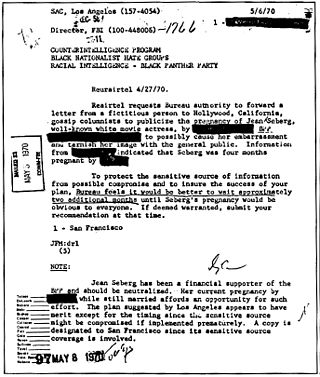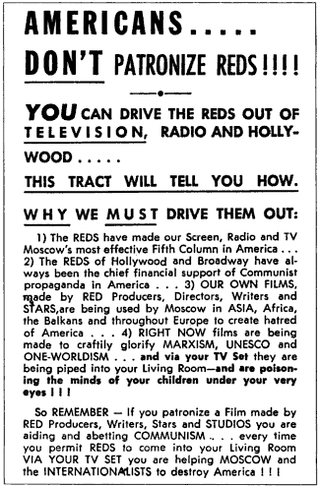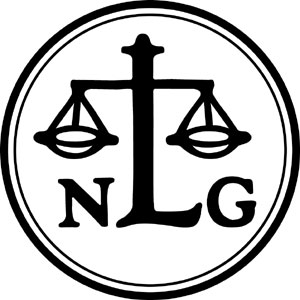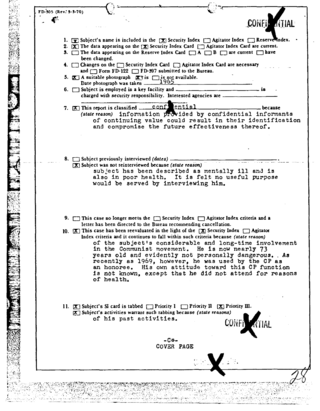Related Research Articles

COINTELPRO was a series of covert and illegal projects actively conducted by the United States Federal Bureau of Investigation (FBI) aimed at surveilling, infiltrating, discrediting, and disrupting domestic American political organizations. FBI records show COINTELPRO resources targeted groups and individuals the FBI deemed subversive, including feminist organizations, the Communist Party USA, anti–Vietnam War organizers, activists of the civil rights and Black power movements, environmentalist and animal rights organizations, the American Indian Movement (AIM), Chicano and Mexican-American groups like the Brown Berets and the United Farm Workers, independence movements, a variety of organizations that were part of the broader New Left, and white supremacist groups such as the Ku Klux Klan and the far-right group National States' Rights Party.

McCarthyism is the practice of making accusations of subversion and treason, especially when related to anarchism, communism, and socialism, and especially when done in a public and attention-grabbing manner.
The United States Senate's Special Subcommittee to Investigate the Administration of the Internal Security Act and Other Internal Security Laws, 1951–77, known more commonly as the Senate Internal Security Subcommittee (SISS) and sometimes the McCarran Committee, was authorized by S. 366, approved December 21, 1950, to study and investigate (1) the administration, operation, and enforcement of the Internal Security Act of 1950 and other laws relating to espionage, sabotage, and the protection of the internal security of the United States and (2) the extent, nature, and effects of subversive activities in the United States "including, but not limited to, espionage, sabotage, and infiltration of persons who are or may be under the domination of the foreign government or organization controlling the world Communist movement or any movement seeking to overthrow the Government of the United States by force and violence". The resolution also authorized the subcommittee to subpoena witnesses and require the production of documents. Because of the nature of its investigations, the subcommittee is considered by some to be the Senate equivalent to the older House Un-American Activities Committee (HUAC).

The National Lawyers Guild (NLG) is a progressive public interest association of lawyers, law students, paralegals, jailhouse lawyers, law collective members, and other activist legal workers, in the United States. The group was founded in 1937 as an alternative to the American Bar Association (ABA) in protest of that organization's exclusionary membership practices and conservative political orientation. They were the first US bar association to allow the admission of minorities to their ranks. The group sought to bring more lawyers closer to the labor movement and progressive political activities, to support and encourage lawyers otherwise "isolated and discouraged," and to help create a "united front" against Fascism.

Red Channels: The Report of Communist Influence in Radio and Television was an anti-Communist document published in the United States at the start of the 1950s. Issued by the right-wing journal Counterattack on June 22, 1950, the pamphlet-style book names 151 actors, writers, musicians, broadcast journalists, and others in the context of purported Communist manipulation of the entertainment industry. Some of the 151 were already being denied employment because of their political beliefs, history, or association with suspected subversives. Red Channels effectively placed the rest on a blacklist.
The Civil Rights Congress (CRC) was a United States civil rights organization, formed in 1946 at a national conference for radicals and disbanded in 1956. It succeeded the International Labor Defense, the National Federation for Constitutional Liberties, and the National Negro Congress, serving as a defense organization. Beginning about 1948, it became involved in representing African Americans sentenced to death and other highly prominent cases, in part to highlight racial injustice in the United States. After Rosa Lee Ingram and her two teenage sons were sentenced in Georgia, the CRC conducted a national appeals campaign on their behalf, their first for African Americans.

President Harry S. Truman signed United States Executive Order 9835, sometimes known as the "Loyalty Order", on March 21, 1947. The order established the first general loyalty program in the United States, designed to root out communist influence in the U.S. federal government. Truman aimed to rally public opinion behind his Cold War policies with investigations conducted under its authority. He also hoped to quiet right-wing critics who accused Democrats of being soft on communism. At the same time, he advised the Loyalty Review Board to limit the role of the Federal Bureau of Investigation (FBI) to avoid a witch hunt. The program investigated over 3 million government employees, just over 300 of whom were dismissed as security risks.
The League of American Writers was an association of American novelists, playwrights, poets, journalists, and literary critics launched by the Communist Party USA (CPUSA) in 1935. The group included Communist Party members, and so-called "fellow travelers" who closely followed the Communist Party's political line without being formal party members, as well as individuals sympathetic to specific policies being advocated by the organization.

The House Committee on Un-American Activities (HCUA), popularly dubbed the House Un-American Activities Committee (HUAC), was an investigative committee of the United States House of Representatives, created in 1938 to investigate alleged disloyalty and subversive activities on the part of private citizens, public employees, and those organizations suspected of having either fascist or communist ties. It became a standing (permanent) committee in 1945, and from 1969 onwards it was known as the House Committee on Internal Security. When the House abolished the committee in 1975, its functions were transferred to the House Judiciary Committee.
The Abraham Lincoln School for Social Science in Chicago, Illinois was a "broad, nonpartisan school for workers, writers, and their sympathizers," aimed at the thousands of African-American workers who had migrated to Chicago from the American South during the 1930s and 1940s.

During the ten decades since its establishment in 1919, the Communist Party USA produced or inspired a vast array of newspapers and magazines in the English language.

The FBI Indexes, or Index List, was a system used to track American citizens and other people by the Federal Bureau of Investigation (FBI) before the adoption of computerized databases. The Index List was originally made of paper index cards, first compiled by J. Edgar Hoover at the Bureau of Investigations before he was appointed director of the FBI. The Index List was used to track U.S. citizens and others believed by the FBI to be dangerous to national security, and was subdivided into various divisions which generally were rated based on different classes of danger the subject was thought to represent.
American Peace Crusade (APC) was an American peace advocacy organization. Established during the Korean War, the federal government identified the organization as a Communist front. Pitirim Sorokin, a Russian American sociologist and professor at Harvard University, was a sponsor of this organization. The Guide to Subversive Organizations and Publications published by the House Un-American Activities Committee (HUAC) characterized APC as a group formed by the Communists to function "as a new instrument for their 'peace' offensive in the United States."
The National Federation for Constitutional Liberties (NFCL) was a civil rights advocacy group made up from a broad range of people.

Counterattack was a weekly subscription-based, anti-communist, mimeographed newsletter, which ran from 1947 to 1955 and was published by a "private, independent organization" of the same name and started by three ex-Federal Bureau of Investigation agents.

William Albertson was a 20th-century American leader in the Communist Party of the USA who battled federal and state courts, and who in 1964 was framed by the Federal Bureau of Investigation, which was only discovered posthumously in 1975. His widow made an out-of-court settlement in 1989 with the U.S. Government for $170,000.
American Committee for the Protection of Foreign Born was the successor group to the National Council for the Protection of the Foreign Born and its successor, seen by the US federal government as subversive for "protecting foreign Communists who come to this country," thus "enabling them to operate here.".
Defending Rights & Dissent (DRAD) is a national not-for-profit advocacy organization in the United States, dedicated to defending civil liberties, exposing government repression, and protecting the right of political dissent. DRAD was formed as the merger of the Defending Dissent Foundation (DDF) and the Bill of Rights Defense Committee (BORDC). DRAD is currently active in defending the right to protest, opposing political surveillance, and campaigning against the prosecution of national security whistleblowers.
References
- ↑ Paul C. Rosier (30 November 2009). Serving their country: American Indian politics and patriotism in the twentieth century. Harvard University Press. pp. 177–. ISBN 978-0-674-03610-9 . Retrieved 25 March 2012.
- 1 2 3 O'Reilly, Kenneth. "Hoover and the Un-Americans" . Retrieved 15 May 2018.
- 1 2 3 Henry M. Holden (15 April 2008). FBI 100 Years: An Unofficial History. Zenith Imprint. pp. 93–. ISBN 978-0-7603-3244-3 . Retrieved 25 March 2012.
- 1 2 United States. Congress. House. Committee on Un-American Activities (1951). Guide to subversive organizations and publications (and appendix). Boston Public Library. Washington [U.S. Govt. Print. Off.
- 1 2 3 4 United States. Congress. House. Committee on Un-American Activities (1961). Guide to subversive organizations and publications (and appendixes). Boston Public Library. Washington.